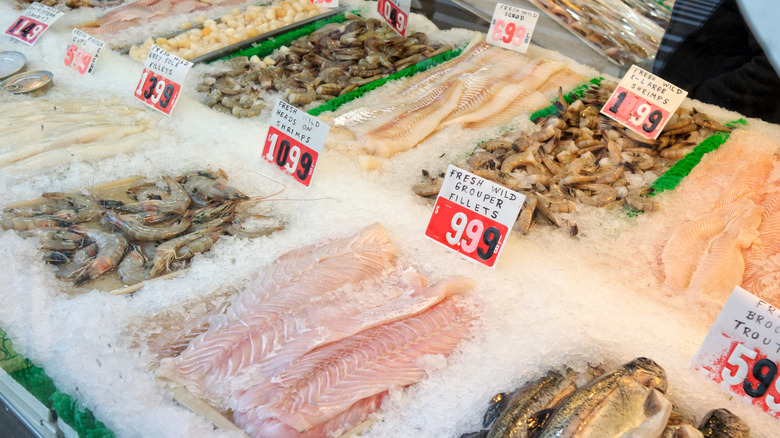Is Monday Really The Absolute Worst Day To Buy Seafood From The Grocery Store?
Anytime you're having seafood, you want it to be as fresh as possible. Fish and other seafood offer a range of delicious flavors and nutritional benefits, but they're also highly perishable. That's why Anthony Bourdain famously advised in his 2000 book, "Kitchen Confidential," not to order fish at restaurants on Mondays, because it had likely been sitting there since Friday. Interestingly, Bourdain reversed himself more than 15 years later, saying things had changed. Is the same true about buying fish from the store? The Takeout spoke to Maricel Gentile, chef and owner of Maricel's Kitchen and author of "Maricel's Simply Asian Cookbook," who shed some light on the topic.
"The old saying comes from the idea that fishermen are not usually out on Sundays, so Monday fish may not be as fresh," Gentile told us. "Today, with global supply chains and large markets, this is less true." Still, the guideline isn't totally outdated. "Still, in smaller markets or coastal towns, it can hold some weight."
The busiest days at grocery store seafood counters are Thursday to Sunday. That's also when you'll find the most types available. If sales are brisk, that means the seafood isn't sitting around for a long time. In other words, shopping on the weekend (and also Thursday) is a good choice. Gentile offered her own sensible suggestion: "My advice is to always buy from a trusted fishmonger, ask when the fish came in, and let your eyes and nose guide you — no matter what day it is."
What to look for when buying seafood
Buying the freshest seafood starts before you get to the store counter. Instead of making the classic grocery list fish mistake of planning to get something specific, be open to seeing and asking what's good that day, including seafood that may be in season. Consider something different if the fishmonger talks it up, like whole fish you can serve to impress guests.
Whether you're buying fish or other seafood, it should have a clean, ocean smell. A fishy or ammonia odor is a sign it's not fresh. Fish should have clear, bulging eyes; bright, shiny skin; red or pink gills; and be firm to the touch. Avoid fish with cloudy, sunken eyes; dry, dull skin; brown or gray gills; or a soft, mushy texture. Fish filets and steaks should have an even color, look moist (no dry edges), and be firm. Shrimp shouldn't be soft or slimy or have black spots. Seafood with hard shells like clams, mussels, and oysters should be tightly closed or should shut when they're tapped if the shell is open. Skip any with cracked or broken shells. Look for active lobsters and crabs whose legs are moving.
Don't overlook frozen seafood. Today, seafood is often flash frozen at sea right after it's caught or onsite (for farmed fish) to maintain freshness and quality. Keep in mind, any 'fresh' fish at the seafood counter is likely to have arrived at the store frozen and then defrosted. Look for frozen fish in vacuum-sealed packages, but avoid thawing it in the package since that could be dangerous.

